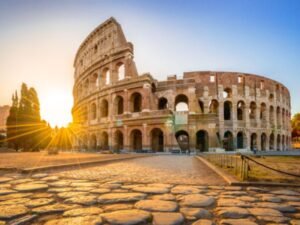Embarking on a journey to explore the wonders of the world is a captivating and enriching experience. From ancient marvels to modern architectural feats, these travel destinations offer a glimpse into the diverse and awe-inspiring beauty our planet has to offer. Join us as we delve into the magic of discovering these extraordinary wonders that have stood the test of time.
1-The Great Wall of China
The Great Wall of China, one of the world’s most iconic landmarks, stands as a testament to human ingenuity, perseverance, and historical significance. Spanning approximately 13,000 miles (21,000 kilometers) across northern China, this colossal structure winds its way through rugged terrains, traversing mountains, plateaus, and deserts.
Historical Significance: Construction of the Great Wall began over 2,000 years ago during the Qin Dynasty, with subsequent dynasties contributing to its expansion and fortification. Initially built for military defense, the wall served as a formidable barrier against invasions from nomadic tribes. Over the centuries, it evolved into a symbol of Chinese strength, resilience, and the enduring spirit of its people.
Architectural Marvel: The Great Wall showcases remarkable engineering feats, incorporating various materials such as earth, wood, bricks, and stone. Watchtowers, garrison stations, and beacon towers dot the wall at strategic intervals, emphasizing its dual role as both a defensive fortification and a communication network. The wall’s meandering path follows the natural contours of the landscape, creating a harmonious blend with its surroundings.

Breathtaking Views: Visitors to the Great Wall are treated to breathtaking panoramic views, especially at sections like Mutianyu and Badaling, which are popular among tourists. The wall’s snaking silhouette against the backdrop of rolling hills and distant mountains provides a captivating sight, particularly during sunrise or sunset.
Cultural Symbol: Beyond its military and architectural significance, the Great Wall of China holds immense cultural value. It embodies the collective spirit of generations of laborers, soldiers, and visionaries who dedicated themselves to its creation and maintenance. Recognized as a UNESCO World Heritage Site, the wall stands as a symbol of China’s rich history and enduring legacy.
Tourist Experience: Today, the Great Wall attracts millions of visitors annually, offering a remarkable journey through history and a chance to walk in the footsteps of ancient warriors. While some sections have been restored for tourism, others remain in their original, weathered state, providing a raw and authentic experience for those seeking a deeper connection with the past.
The Great Wall of China is more than just a physical barrier; it is a testament to the human spirit’s ability to overcome challenges and leave an indelible mark on the world. As a symbol of China’s rich cultural heritage, the Great Wall invites travelers to marvel at its grandeur, appreciate its historical significance, and contemplate the enduring legacy it represents.
2-Machu Picchu, Peru
Nestled high in the Andes Mountains of Peru, Machu Picchu stands as a mystical testament to the architectural brilliance and cultural achievements of the ancient Inca civilization. This UNESCO World Heritage Site, often referred to as the “Lost City of the Incas,” captivates visitors with its breathtaking scenery, intricate stone structures, and enigmatic historical significance.
Historical Marvel: Built in the 15th century during the reign of the Inca emperor Pachacuti, Machu Picchu served as a royal estate and religious sanctuary. Constructed with meticulous precision, the site boasts stunning stone terraces, temples, plazas, and residential areas, all ingeniously integrated into the natural landscape.
Intricate Architecture: The architecture of Machu Picchu is a testament to the Inca’s advanced understanding of engineering and aesthetics. The precise fitting of enormous stone blocks without the use of mortar is a marvel that has withstood centuries of earthquakes and weathering. The Intihuatana stone, a ritual stone associated with astronomy, and the Temple of the Sun are among the many highlights showcasing the Inca’s mastery in construction.

Breathtaking Scenery: Situated at an elevation of around 7,970 feet (2,430 meters), Machu Picchu offers awe-inspiring views of the surrounding Andes Mountains. The site is strategically positioned between two peaks—Huayna Picchu and Machu Picchu Mountain—adding to its mystique and providing stunning vantage points for visitors.
Cultural Significance: Machu Picchu holds immense cultural and spiritual significance for the descendants of the Inca civilization. The site is believed to have had astronomical and agricultural purposes, emphasizing the Inca’s deep connection with nature and the cosmos.
Discovery and Preservation: Although known to locals, Machu Picchu remained largely unknown to the outside world until its rediscovery by American historian and explorer Hiram Bingham in 1911. Since then, it has become one of the most visited archaeological sites globally, attracting millions of tourists annually. Efforts to preserve and protect Machu Picchu’s fragile ecosystem and historical structures are ongoing to ensure its legacy endures for future generations.
Tourist Experience: Travelers to Machu Picchu can reach the site via the iconic Inca Trail trek or by train, experiencing a sense of anticipation as they approach the citadel. Exploring the stone-paved paths, ascending to the Sun Gate, and witnessing the sunrise over the ruins contribute to a once-in-a-lifetime experience that leaves an indelible mark on visitors.
Machu Picchu remains an extraordinary destination that not only showcases the architectural genius of the Inca but also invites modern-day explorers to connect with the mysteries of a bygone era. Its ethereal beauty, surrounded by the breathtaking landscapes of the Andes, ensures that Machu Picchu continues to be a symbol of Peru’s rich cultural heritage and a beacon for those seeking to unravel the secrets of the past.
3-The Pyramids of Giza, Egypt
Standing proudly on the vast plateau of Giza, just outside Cairo, the Pyramids of Giza are among the most iconic and enduring symbols of ancient Egypt. This architectural marvel, comprising the Great Pyramid of Khufu, the Pyramid of Khafre, the Pyramid of Menkaure, and the enigmatic Sphinx, has captured the imagination of people worldwide for millennia.
Historical Significance: Constructed during the Fourth Dynasty of the Old Kingdom, around 2580–2560 BCE, the Pyramids of Giza served as monumental tombs for pharaohs and high-ranking officials. The Great Pyramid, built for Pharaoh Khufu, was the tallest man-made structure in the world for over 3,800 years.
Architectural Grandeur: The precision and sophistication of the pyramid construction are awe-inspiring. Composed of massive limestone and granite blocks, the pyramids were meticulously aligned with astronomical precision, reflecting the ancient Egyptians’ advanced understanding of mathematics and engineering.
The Great Pyramid of Khufu: Khufu’s Pyramid, the largest of the three, originally stood at 146.6 meters (481 feet) and is composed of approximately 2.3 million limestone blocks. Its sheer scale and precision continue to baffle historians and archaeologists, sparking countless theories about the construction methods employed by the ancient Egyptians.
The Sphinx: Adjacent to the pyramids lies the Sphinx, a colossal limestone statue with the body of a lion and the face of a pharaoh, commonly believed to represent Khafre. The Sphinx adds an air of mystery to the Giza plateau and is thought to have functioned as a guardian of the pyramids.
Cultural and Spiritual Significance: Beyond their architectural prowess, the Pyramids of Giza hold immense cultural and spiritual significance. The ancient Egyptians believed in an afterlife, and the construction of these grand structures was intricately linked to religious beliefs, emphasizing the pharaoh’s journey to the afterlife.

Tourist Experience: Today, the Pyramids of Giza attract millions of visitors each year, offering an immersive journey into the heart of ancient Egyptian civilization. Visitors can explore the interiors of some pyramids, marvel at the colossal Sphinx, and enjoy panoramic views of the pyramids from various vantage points.
Ongoing Mysteries: Despite centuries of exploration and study, the Pyramids of Giza continue to captivate scholars and enthusiasts alike. Questions surrounding the construction techniques, purpose, and astronomical alignments persist, contributing to the enduring allure of these ancient wonders.
The Pyramids of Giza stand not only as a testament to the architectural achievements of ancient Egypt but also as a symbol of the cultural and spiritual depth of one of the world’s most remarkable civilizations. As enduring symbols of human ingenuity, these colossal structures invite us to reflect on the mysteries of the past and the enduring legacy of the pharaohs who envisioned these monumental structures.
4-The Taj Mahal, India
Gracefully standing on the banks of the Yamuna River in Agra, India, the Taj Mahal is a testament to the eternal beauty of love and a jewel in the crown of architectural wonders. This ivory-white marble mausoleum, renowned for its intricate design and poignant history, is considered one of the most exquisite structures ever built.
Historical Origin: Commissioned by Emperor Shah Jahan in memory of his beloved wife Mumtaz Mahal, who passed away during childbirth in 1631, the Taj Mahal’s construction commenced in the same year and took over two decades to complete. The architectural ensemble, including the main mausoleum, the mosque, and the jawab (a building mirroring the mosque), reflects a harmonious blend of Persian, Islamic, and Indian architectural styles.
Architectural Splendor: The Taj Mahal’s architectural brilliance lies in its symmetrical layout and meticulous detailing. The main mausoleum features a central dome surrounded by four smaller domes, while minarets frame the structure on either side. The entire complex is set within beautifully landscaped gardens, with reflecting pools adding to the ethereal beauty of the monument.
Marble Inlay and Ornamentation: What distinguishes the Taj Mahal is its intricate marble inlay work. Semi-precious stones such as lapis lazuli, jasper, turquoise, and onyx are skillfully embedded into the white marble, creating exquisite floral and geometric patterns. As the sun traverses the sky, the changing light imparts a radiant glow to the marble surface.

Symbol of Eternal Love: The Taj Mahal is often referred to as the “epitome of love” due to the poignant story behind its creation. Shah Jahan’s deep love for Mumtaz Mahal is immortalized in the serene beauty of this mausoleum. The intricate carvings and inscriptions from the Quran that adorn the walls add to the spiritual and romantic ambiance of the structure.
Cultural Heritage: Recognized as a UNESCO World Heritage Site, the Taj Mahal attracts millions of visitors annually from around the globe. It is not merely a mausoleum but a symbol of India’s rich cultural heritage and a testament to the enduring power of love.
Sunset and Sunrise Views: Visitors to the Taj Mahal are often enchanted by the mesmerizing views at sunrise and sunset. As the sun bathes the monument in golden hues, the changing colors of the sky create a magical ambiance that adds to the overall enchantment of the experience.
Preservation Efforts: To preserve the Taj Mahal’s pristine beauty, conservation efforts and strict regulations have been implemented to mitigate the impact of pollution and wear over time. These measures ensure that future generations can continue to marvel at the architectural splendor of this timeless masterpiece.
The Taj Mahal stands as an unparalleled symbol of love, architectural brilliance, and cultural richness. Its ethereal beauty and timeless elegance make it not just a national treasure but a global symbol that transcends boundaries, inviting visitors to witness the enduring legacy of a love story carved in stone.
The Colosseum, Italy
Nestled in the heart of Rome, Italy, the Colosseum stands as a grand testament to the architectural prowess and cultural significance of ancient Rome. This colossal amphitheater, also known as the Flavian Amphitheatre, has withstood the test of time and remains one of the most iconic landmarks in the world.
Historical Origin: Commissioned by Emperor Vespasian of the Flavian dynasty in AD 72, the construction of the Colosseum was completed under his successor, Emperor Titus, in AD 80. Originally used for gladiatorial contests, public spectacles, and theatrical performances, the Colosseum became a symbol of Roman entertainment and engineering mastery.
Architectural Marvel: The Colosseum’s architecture is a marvel of ancient engineering. Built using concrete and sand, the amphitheater could accommodate over 50,000 spectators, featuring a complex system of ramps, chambers, and tunnels beneath the arena floor. Its elliptical shape and tiered seating allowed for efficient crowd management during events.
Gladiatorial Contests: The Colosseum gained fame for hosting gladiatorial contests, where skilled fighters engaged in mortal combat for the entertainment of the Roman populace. The arena also hosted mock sea battles and animal hunts, showcasing the versatility of the amphitheater for various forms of spectacle.
Symbol of Roman Ingenuity: Beyond its role as an entertainment venue, the Colosseum symbolizes Roman engineering ingenuity and architectural innovation. The use of arches, columns, and decorative elements reflects the classical principles of Roman design, influencing subsequent architectural styles throughout history.

Destruction and Preservation: Over the centuries, earthquakes, fires, and stone-robbers took a toll on the Colosseum, leading to substantial damage. However, preservation efforts initiated in the 19th century and ongoing restoration projects have helped maintain the structure’s integrity, allowing visitors to marvel at its grandeur today.
Iconic Features: The Colosseum’s iconic features include its massive outer wall with arches and columns, the intricate network of passageways, and the arena floor where gladiatorial contests took place. The elliptical shape allowed for optimal viewing from any seat in the amphitheater.
Tourist Attraction: Today, the Colosseum attracts millions of visitors annually, drawing history enthusiasts, architects, and tourists eager to witness the magnificence of ancient Rome. Guided tours provide insights into the amphitheater’s history, architecture, and the cultural significance of the events that unfolded within its walls.
Cultural Legacy: Recognized as a UNESCO World Heritage Site, the Colosseum remains a symbol of Roman culture and endurance. Its enduring legacy extends beyond its historical importance, serving as a powerful reminder of the grandeur and spectacle that characterized ancient Roman society.
The Colosseum stands as an indelible symbol of ancient Rome’s architectural and cultural legacy. Its imposing presence and rich history make it a must-visit destination, offering a glimpse into the vibrant and dramatic events that unfolded within its walls, shaping the course of Roman history.
Exploring these wonders of the world is a journey that transcends time and connects us to the rich tapestry of human history. Each destination tells a unique story, offering travelers an opportunity to witness the architectural brilliance, cultural heritage, and natural beauty that make our world truly extraordinary. Whether you are a history enthusiast, an adventurer, or a seeker of beauty, these wonders await, inviting you to embark on a voyage of discovery and wonder.










